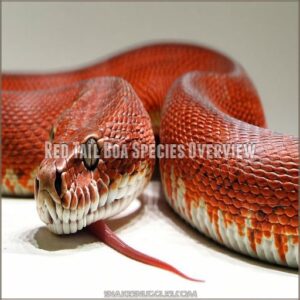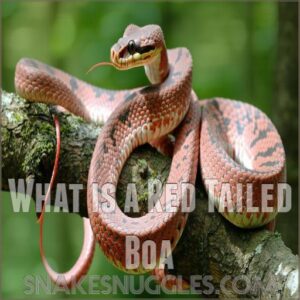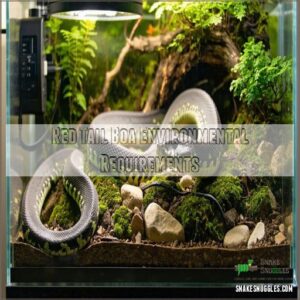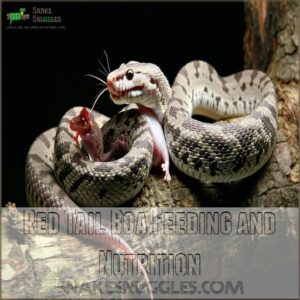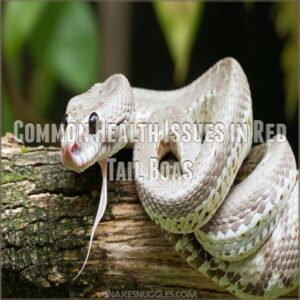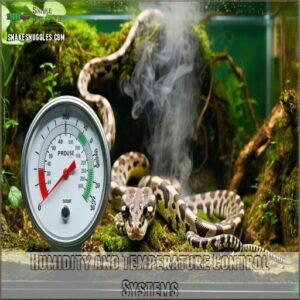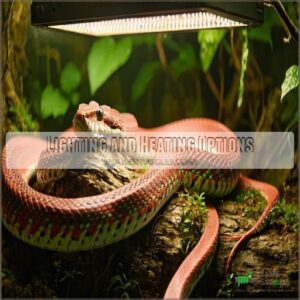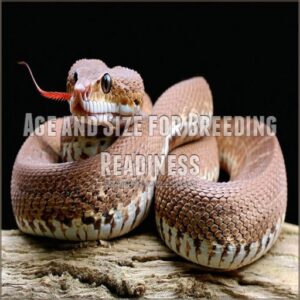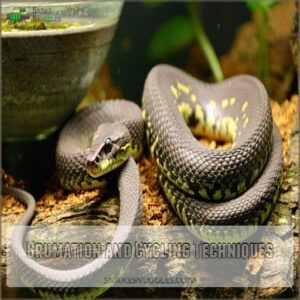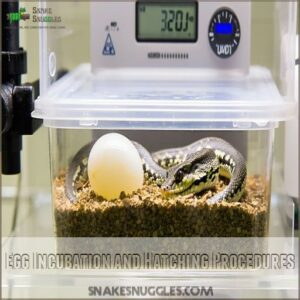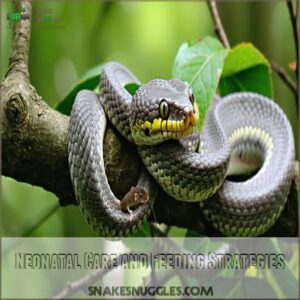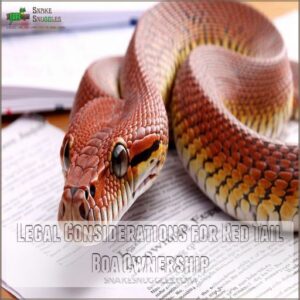This site is supported by our readers. We may earn a commission, at no cost to you, if you purchase through links.
 Oh, you’re curious about the majestic red-tailed boa, are you? Well, let me tell you, these stunning snakes are native to South America and are renowned for their striking red-hued tails.
Oh, you’re curious about the majestic red-tailed boa, are you? Well, let me tell you, these stunning snakes are native to South America and are renowned for their striking red-hued tails.
They’re a popular choice among reptile enthusiasts due to their manageable size and friendly temperament.
With the right habitat setup and care, these red-tailed beauties can thrive in captivity, growing up to 10 feet long and living over 20 years.
Now, I bet you’re wondering what it takes to keep one of these impressive constrictors as a pet.
Let’s get into the details of red-tailed boa ownership, shall we?
Table Of Contents
- Key Takeaways
- Red Tail Boa Species Overview
- What is a Red Tailed Boa
- Red Tail Boa Environmental Requirements
- Red Tail Boa Behavior and Temperament
- Red Tail Boa Feeding and Nutrition
- Common Health Issues in Red Tail Boas
- Red Tail Boa Enclosure Setup
- Breeding Red Tail Boas in Captivity
- Legal Considerations for Red Tail Boa Ownership
- Frequently Asked Questions (FAQs)
- How aggressive are red tail boas?
- Is a red tail boa a good pet?
- How big will a red tail boa get?
- Do red tail boas like to be held?
- Are red tail boas good starter snakes for beginners?
- How do red tail boas breed in the wild?
- What is the average lifespan of a red tail boa?
- Can red tail boas be kept in groups?
- What are the common illnesses in red tail boas?
- Conclusion
Key Takeaways
- Provide your red-tailed boa with a spacious enclosure, proper temperature and humidity levels, and plenty of hiding spots to keep it healthy and happy.
- Handling your boa gently and regularly can help it feel comfortable around you, but be mindful of signs of stress or aggression.
- Feed your boa appropriately-sized prey at the right frequency, and supplement its diet with necessary vitamins and minerals.
- Research your local laws and be prepared for the long-term commitment of owning a large, long-lived snake before bringing home a red-tailed boa.
Red Tail Boa Species Overview
Red tail boas are one of the most popular reptile pets, known for their distinctive red-tipped tails and docile temperament.
You’ll learn all about the key characteristics, behaviors, and care requirements of these fascinating snakes, including the importance of providing proper housing, in the guide ahead.
Boa Constrictor Constrictor Characteristics
The boa constrictor constrictor, also known as the red-tailed boa, is quite the marvel.
Imagine a predator with an impressive anatomy, sporting powerful muscles for constricting prey.
Lack of venom doesn’t hold them back—they’re skilled at ambushing.
Their diet primarily consists of rodents.
Red Tail Boas are ovoviviparous, meaning their young develop from eggs that hatch internally during a 100-120 day gestation period for boa constrictors. Reproduction is fascinating too, as they give birth to live young, skipping the whole egg-laying scene.
Geographical Distribution and Habitat
Red tail boas are found across parts of South America, thriving in diverse tropical environments.
They call lush rainforests, savannas, and even semi-arid regions home.
These adaptable snakes dwell near human settlements, attracted by the plentiful rodent prey.
While resilient, habitat loss poses risks – we must protect their wild populations for future generations to enjoy.
Lifespan and Growth Rate
Ever wonder how long a red tail boa can stick around? These mesmerizing creatures can live 20 to 30 years in captivity, given the right care.
- Juvenile development: Rapid in the first few years.
- Adults: Typically reach 6-8 feet.
- Diet and care: Major growth rate factors.
- Temperature and humidity: Essential for well-being.
- Regular feeding: Keeps growth on track.
Temperament and Behavior
Imagine sharing your space with a red-tailed boa, whose temperament is generally calm yet can shift with perceived threats.
When properly socialized, they can make docile pets, as seen with boa constrictor constrictor and imperator.
They communicate through defensive mechanisms—hisses, and body posture changes.
Handling techniques become art forms, requiring patience and gentleness.
Recognize stress indicators like excessive hiding or refusal to feed.
Understand their independent nature yet enjoy the melody of their unique snake behavior and social interactions.
What is a Red Tailed Boa
Red tail boas are one of the most popular pet snake species, known for their striking appearance.
With their distinctive red-tinted tails and a range of color variations, these non-venomous constrictors make fascinating companions for experienced reptile owners.
Red Tail Boa Appearance and Size
So, you’re ready to meet your new scaly friend? Let’s talk about their look and size.
Adult red tailed boas (Boa constrictor constrictor) typically reach 6 to 8 feet, though some hit 10 feet, with a girthier build and deeper red tail compared to other subspecies like the Boa constrictor imperator characteristics.
Females are usually bigger than males.
Their growth is gradual, a slow and steady process.
Knowing their size helps you choose the right enclosure, ensuring your boa has enough space to thrive.
It’s all about creating the perfect home for your new pet.
Base Colors and Pattern Variations
Red Tailed Boas boast an impressive array of color morphs and pattern variations.
From the classic tan and brown hues to striking albino mutations, these snakes display a diverse genetic palette.
Explore the Colombian Red Tail’s olive-gray base or marvel at the fiery orange tones of select color morphs.
Each boa is a unique work of natural art.
Distinctive Red Tail Markings
The most striking feature of the red tail boa is the distinctive red coloration that blossoms at the end of its tail.
This vivid red hue can range from a deep maroon to a brilliant scarlet, serving both as camouflage in the wild and a compelling display for owners.
Observing the way the red fades into the snake’s base color is a mesmerizing sight.
Size Differences Between Males and Females
While both male and female red tail boas can grow quite large, females typically reach around 8 feet in length, compared to males who max out around 6 feet.
Sexual dimorphism has implications for their care, as females will require a larger enclosure and greater feeding amounts compared to their smaller male counterparts.
Popular Morphs and Color Variations
Dozens of interesting morphs and color variations exist within the Red Tail Boa species, and many enthusiasts rely on online marketplaces like Red Tail Boa Products to find the perfect pet.
From the striking Albino Red Tail with its light base and bold orange patterning, to the Caramel Red Tail‘s warm, earthy tones, these snakes come in a diverse array of stunning hues and patterns that make them sought-after pets.
Red Tail Boa Environmental Requirements
Providing your red-tailed boa with the right environment is essential for its health and wellbeing.
You’ll need to carefully control the temperature, humidity, and other factors to create the perfect habitat for your scaly friend.
Enclosure Size and Dimensions
Outfitting an adequate home for your red tail boa is essential.
These big snakes need a spacious enclosure, measuring at least 6 feet long, 2 feet wide, and 2 feet tall for an adult.
Provide ample room for your boa to stretch out and explore without feeling cramped or stressed.
The right-sized cage will keep your pet healthy and happy. Choosing a terrarium that is appropriate for the snake’s adult size, such as considering adult size, is crucial for good aeration and easy cleaning. The right-sized cage will keep your pet healthy and happy.
Habitat Setup and Substrate Options
Crafting the perfect red tail boa habitat calls for careful consideration of substrate choices.
Cypress mulch is a safe bet, as it retains humidity well.
Be wary of cedar and aspen – they may emit toxic fumes.
Provide ample hiding spots with log hides, branches, and plants to give your snake a sense of security and control over its environment.
Temperature and Lighting Requirements
To keep your red tail boa comfortable, maintain a temperature gradient in its enclosure.
Set up a basking spot around 95-100°F, while the ambient temps should range from 80-85°F.
Use heat lamps or under-tank heaters to achieve this thermal gradient.
Proper lighting and ventilation are also key for your snake’s wellbeing.
Humidity and Water Quality
Maintaining the proper humidity levels and water quality is very important for your red tail boa’s health.
Aim for 60-80% humidity, using a hygrometer to monitor it.
Provide a large, sturdy water bowl that allows the snake to soak.
Change the water frequently and test it periodically to make sure it’s clean and free of contaminants.
A well-maintained habitat will keep your red tail boa thriving.
Red Tail Boa Behavior and Temperament
Red tail boas are typically docile but can constrict or bite if they feel threatened.
Handling your red tail boa regularly will keep it accustomed to human interaction and prevent any aggressive behavior.
Handling and Taming Techniques
Handling your red tail boa requires a gentle, gradual approach, starting with thorough preparation and attention to the boa’s body language and comfort, as discussed in boa constrictor handling tips.
Start by allowing the snake to get accustomed to your presence, offering food by hand, and slowly increasing contact over time.
Be patient and consistent – rushing the process can undermine trust and lead to defensive behaviors.
With time and care, your boa will learn to feel secure around you.
Establishing Trust and Reducing Stress
For a successful snake-human bond, you need to strike a balance between consistency and empathy.
Once you’re comfortable with handling techniques, you can focus on:
- Setting Boundaries: Respect your boa constrictor’s space, easing into interactions.
- Regular Socialization: Engage it consistently to build familiarity and reduce stress.
- Enrichment: Offer diverse stimuli to maintain interest and well-being.
Understanding snake behavior patterns aids in fostering trust.
Signs of Aggression or Discomfort
With a red tail boa, aggressive body language like tail whipping, hissing, and striking may signal discomfort.
Pay close attention to their defensive posture – a flattened head and coiled stance often precedes a bite.
Handle these powerful constrictors calmly and confidently to avoid triggering any fearful responses.
Frequency and Duration of Handling Sessions
Aim to handle your red tail boa regularly, but don’t overdo it.
Start with short 5-10 minute sessions a few times per week, and consider wearing Red Tail Boa Gloves to protect yourself from potential scratches.
As the snake gets older and more accustomed to handling, you can gradually increase the frequency and duration.
This helps build trust and reduce stress.
But always pay attention to signs of discomfort.
Red Tail Boa Feeding and Nutrition
Feeding your red tail boa can be a delicate balance, as you’ll want to offer prey items no larger than the widest part of the boa’s body for optimal nutrition, according to expert boa constrictor nutrition. but with the right approach, you’ll keep your snake happy and healthy.
Choosing the appropriate prey size and establishing the ideal feeding schedule are crucial for providing your red tail boa with proper nutrition.
Appropriate Prey Size and Type
Getting to know your red tail boa’s dietary needs is key to a healthy snake.
For prey items, stick with rodents that are approximately the same width as your snake’s widest part.
Think of it as finding the perfect fit for a cozy sweater.
Choose pre-killed prey for safety, ensuring it’s fresh.
This caters to your snake’s natural instincts without extra risks.
Feeding Frequency by Age and Size
As your red tail boa grows, its feeding regimen will evolve.
Start juveniles on smaller prey like fuzzies, graduating to mice and eventually rats.
Adult red tails can consume larger meals like rabbits and jumbo rats.
Adjust portion sizes to maintain a healthy body weight, scaling up the prey as your snake matures.
Pre-killed Vs. Live Prey Considerations
When feeding your red tail boa, you’ll need to decide whether to offer pre-killed or live prey.
Live prey taps into the snake’s natural hunting instinct, but can pose safety risks if the prey fights back.
Pre-killed food eliminates this concern, though your snake may find it less enticing.
Consider your comfort level and prioritize your pet’s wellbeing.
Supplementation and Dietary Variety
Red-tailed boas are capable of going without eating for up to 168 days due to their slow metabolism and fat-storing abilities, as observed in their natural fasting patterns. Supplementing your red tail boa’s diet with calcium, vitamin D3, and multivitamin supplements is key to ensuring proper nutrition.
Incorporate prey variety, like frozen-thawed rodents of appropriate size, to provide a well-rounded diet.
Gut-loading feeder rodents with nutrient-rich foods enhances their nutritional value for your snake.
Common Health Issues in Red Tail Boas
As a responsible red tail boa owner, you’ll need to keep an eye out for common health issues like respiratory infections, scale rot, and inclusion body disease.
Though these conditions can be serious, they’re often manageable with prompt veterinary care and proper enclosure maintenance.
Respiratory Infections and Treatment
Respiratory infections in your red-tailed boa are no laughing matter.
Symptoms like wheezing, mouth-breathing, and nasal discharge require prompt vet care.
Poor husbandry, such as inadequate humidity and sanitation, can lead to these issues, so it’s important to understand treating snake respiratory infections.
Nip these issues in the bud with a proper setup – ample humidity, clean water, and stress-free environments are your snake’s best defense.
Act fast, and your scaly friend will be back to full health in no time.
Scale Rot and Blister Disease Prevention
Keeping your red tail boa’s enclosure spotlessly clean is important to prevent scale rot and blister disease.
Make sure humidity levels are high, provide a proper substrate, and keep the water bowl clean.
At the first signs of discoloration or scaling issues, consult a reptile vet to nip any skin problems in the bud.
Inclusion Body Disease (IBD) and Diagnosis
Inclusion Body Disease (IBD) is a fatal retrovirus that can lay dormant in red tail boas for years.
Watch for signs like poor appetite, excessive saliva, and loss of bodily control.
While incurable, early detection and supportive care can help manage IBD’s progression.
Work closely with a vet to monitor your snake’s health.
- Recognize early IBD symptoms like loss of appetite.
- Understand IBD’s genetic and environmental risk factors.
- Work with a reptile vet to properly diagnose and manage IBD.
Parasitic Infestations and Prevention
Parasitic infestations can pose serious risks to your red tail boa’s health.
Watch out for signs like lethargy, weight loss, or skin irritation.
Routine fecal tests can catch internal parasites early.
External parasites like mites may require medicated washes.
Following proper hygiene and quarantine protocols is key to preventing infections.
Consult a reptile vet if you suspect any issues.
Red Tail Boa Enclosure Setup
Setting up the perfect red tail boa enclosure is very important to your pet’s health and happiness.
You’ll need to provide the right temperatures, humidity levels, and hiding spots to make sure your scaly friend feels right at home.
Cage Size and Dimension Requirements
When housing an adult red tail boa, you’ll want an enclosure measuring at least 6 feet long, 2 feet wide, and 2 feet tall.
Juvenile boas can start in smaller 4x2x2 foot tanks, but be sure to upgrade as they grow.
Provide ample space for your snake to move around comfortably and stretch out.
Essential Furniture and Hiding Spots
Once your red tail boa’s new home is set up, it’s time to add some essential decor.
Snakes love to hide, so incorporate a mix of purchased and DIY hiding spots, like hollow logs, sturdy plants, or even an overturned plastic tub.
Spread them throughout the enclosure so your boa can feel secure no matter where it lounges.
Humidity and Temperature Control Systems
Maintaining the right humidity and temperature is essential for your red tail boa’s health.
Aim for 60-80% humidity and a temperature gradient of 80-85°F ambient and a 95-100°F basking spot.
Invest in a high-quality hygrometer and thermostat to precisely control these factors.
A fogger can boost humidity, while ceramic heaters or heat lamps regulate temperatures.
Lighting and Heating Options
To keep your red tail boa cozy, pick the right heat sources.
Heat lamps paired with thermostats provide stable warmth, while UVB lighting supports their health.
Create a basking spot with a heat mat in your snake’s enclosure, delivering the power of the sun indoors.
Balance lighting and heating devices to mimic natural habitats, improving your pet’s well-being.
Breeding Red Tail Boas in Captivity
Breeding your red tail boa can be a rewarding experience. With patience and the right techniques, you can successfully incubate the eggs and care for the hatchlings.
Age and Size for Breeding Readiness
Timing is key when breeding red tail boas.
Females are typically ready to mate around 3-4 years old and 5-6 feet in length.
Males usually mature a bit earlier at 2-3 years and 4-5 feet.
Pay close attention to their size and wait for those signs before introducing potential mates.
Brumation and Cycling Techniques
Preparing your red tail boa for breeding season involves carefully managing the brumation cycle.
Begin by gradually lowering temperatures and decreasing feeding over several months, allowing your snake to enter a dormant state.
When ready to breed, slowly increase temps and offer more food to stimulate their natural mating behaviors.
Proper brumation and cycling is key to successful reproduction.
Egg Incubation and Hatching Procedures
As you shift focus from brumation, consider the art of incubating red-tailed boa eggs. Keep those eggs at temperatures around 86°F with 90% humidity for ideal development.
Here’s your handy guide:
- Maintain stable incubator conditions.
- Regularly check for moisture and temperature.
- Monitor eggs for signs of viability.
- Prepare for potential hatching assistance.
Neonatal Care and Feeding Strategies
Congrats on your baby red tail boa! Now it’s time to make sure they thrive. Start feedings with appropriately-sized prey, like fuzzies or small mice. Weigh them regularly and adjust their diet as they grow. Maintain their enclosure’s temps and humidity – they’ll need that cozy environment. With proper care, your little one will soon be slithering around with confidence!
Offer appropriately-sized prey
Maintain 80-85°F ambient, 95-100°F basking
60-80%
Minimize disturbance, let them acclimate
Track growth weekly
| Feeding | Temperature | Humidity | Handling | Weighing |
|---|---|---|---|---|
| Offer appropriately-sized prey | Maintain 80-85°F ambient, 95-100°F basking | 60-80% | Minimize disturbance, let them acclimate | Track growth weekly |
Legal Considerations for Red Tail Boa Ownership
Before bringing home a red tail boa, a popular yet large snake, it’s essential to research the largest snake that you can own to understand their needs and requirements, check your local laws – some areas restrict or ban exotic pet ownership.
You’ll also need to think about the long-term responsibilities and costs of caring for these large, long-lived snakes.
State and Local Regulations and Permits
Before you bring home a red tail boa, check your state and local laws.
Some areas require special permits or banning these snakes outright.
Research the licensing process thoroughly to make sure you comply with all regulations.
Responsible pet ownership means following the rules, so be sure you fully understand your state’s exotic animal laws.
Ethical Sourcing and Conservation Status
While redtailed boas are classified as "Least Concern" on the IUCN Red List, their wild populations may be declining due to the pet trade.
To guarantee ethical sourcing and conservation, opt for captive-bred specimens from reputable breeders.
This supports responsible ownership and helps protect wild boa populations.
- Choose captive-bred redtails to avoid contributing to wild population decline.
- Research sellers thoroughly to guarantee transparent and ethical breeding practices.
- Support conservation efforts by purchasing from breeders actively involved in species protection.
Responsibilities of Red Tail Boa Ownership and Care
Owning a red tail boa is a big responsibility.
You’ll need a sizable enclosure, such as those available at Red Tail Boa Enclosure products Red Tail Boa Enclosures, specialized lighting and heating, and a specific diet.
Regular vet check-ups and monitoring for health issues are musts.
Plus, research your local laws – some areas restrict or ban these majestic snakes.
With proper care, your red tail boa can thrive for decades.
Frequently Asked Questions (FAQs)
How aggressive are red tail boas?
Red tail boas aren’t typically aggressive, but they can constrict or bite if threatened.
With proper handling and socialization, they make docile pets.
Just be cautious, as their size and strength require extra care when owning one.
Is a red tail boa a good pet?
Red-tailed boas can make decent pets for experienced reptile owners, but they require serious commitment.
Red-tailed boas are generally docile, but their large size, strength, and long lifespan make them a significant responsibility not suited for most first-time snake owners.
How big will a red tail boa get?
Red tail boas can reach impressive lengths of 6-9 feet, with some individuals growing up to 11 feet, and weigh around 20-60 pounds, making them a sizable pet.
Do red tail boas like to be held?
They can be quite curious and enjoy interacting with their owners.
Proper handling is key – they may become defensive if feeling threatened.
Patience and gradual acclimation is important when getting a red tail boa comfortable with being held.
Are red tail boas good starter snakes for beginners?
As slippery as an eel, red tail boas can make great starter snakes for brave beginners – if you’ve got the space, patience, and dedication to meet their substantial needs.
Just be aware they’ll pack a punch as they grow.
How do red tail boas breed in the wild?
In the wild, red tail boas breed through a courtship ritual where the male pursues and wraps around the female.
Gestation lasts 4-6 months, after which the female gives birth to 10-60 live young.
The newborns are self-sufficient and independent from birth.
What is the average lifespan of a red tail boa?
Life is a gift – with proper care, your red tail boa can mesmerize you for decades, living 20 to 30 years on average.
These patient, powerful reptiles defy the limits of time when you commit to their wellbeing.
Can red tail boas be kept in groups?
You can’t keep red tail boas in groups.
They’re solitary snakes that’ll likely fight and stress each other out.
Stick to housing just one at a time for their health and wellbeing.
What are the common illnesses in red tail boas?
Red tail boas can suffer from respiratory infections, stuck sheds, and inclusion body disease.
Signs of illness include wheezing, mucus discharge, and poor appetites.
If you notice any of these signs, you’ll need to visit an experienced reptile vet.
Conclusion
With their striking appearance, manageable size, and friendly temperament, it’s no wonder the majestic red-tailed boa remains a popular choice among reptile enthusiasts.
Whether you’re a seasoned snake owner or a first-time keeper, the red-tailed boa is a truly remarkable species worth considering.
By following the detailed care guidelines outlined in this guide, you’ll be well on your way to providing a safe and enriching environment for your amazing red-tailed companion.

